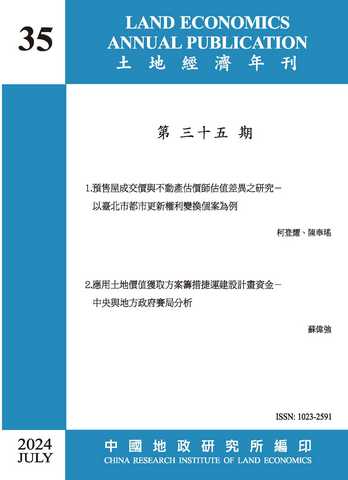 |
 本站僅提供期刊文獻檢索。 本站僅提供期刊文獻檢索。
【月旦知識庫】是否收錄該篇全文,敬請【登入】查詢為準。
 最新【購點活動】 最新【購點活動】
|
| 篇名 |
日治時期臺灣租佃制度之探討──由「贌耕權」到「三七五減租條例」
|
| 並列篇名 |
Discussion of the Taiwan Tenancy System during Japanese Rule |
| 作者 |
周茂春 |
| 中文摘要 |
日治時代之租佃制度,有其時代背景與特殊性,這種租佃制度始自荷人招引中國移民到台開墾,墾成的土地歸荷蘭國王所有,但墾民取得「樸更權」。清領後,閩粵地區漢人陸續移民台灣,台灣特有的「墾田」制,導+R5致租佃制度盛行。日本領台之初,以「台灣慣例」承認現有土地權屬與租佃關係。1898年(明治31年)9月展開之土地調查事業,未申報者收歸國有。原所有人變成公有地承租人。1905年發布「台灣土地登記規則」,規定業主權、樸耕權之得喪變更均需依規定登記才生效力。自1923年(大正12年)起日本民商法施行於台灣,樸耕權依其內涵改換成土地權、永佃權、租凴之名稱辦理登記,租佃耕地只要有書面契約即獲法律保障。但台灣地狹人稠,土地集中在少數地主手裡,地主慣以「口頭約定」方式立約,租期短,押金高,租金超重等條款,形成不合理租佃關係。日本當局雖於1922年後再各地成立「業佃會」、「地主、佃農協調會」等組織,從事租佃改善工作,但績效不佳。台灣光復後政府推動土地改革運動,訂立「三七五減租條例」,一舉將多來不合理租佃慣習廢止,接著再進行「公地放領」、「耕者有其田」等政策,開啟新的租佃制度。綜觀日治時期之台灣租佃制度,日本當局對被壓榨的小農,不屑一顧。積弊已久之租佃制度,並無魄力加以改革。難怪對日人統治,草地人並沒像城市人般留下好印象,反而深藏著台灣農民運動所留下的斑斑傷痕。
Tenancy system under the Japanese ruled periods was developed from its peculiar background and particularity which starting from the Dutch that permit Chinese immigrants to open up wasteland, and the ownership belonged to Holland king and the land created- cultivated people who obtained “the plowing right”. After Ching’s rule, the Han people of the Fujian and Guangdong area immigrated one after another to Taiwan and Taiwan unique “open land created -cultivated fields” system, causing the tenancy system to be in vogue. At the beginning of Japan ruling Taiwan, the acknowledgment of existing land ownership was by “conventions” between the tenancy relations. In 1898 (the Meiji 31) They Japanese launched “the land investigation enterprise”: The land which not reported to authority will be nationalized. Therefore, the previous land owner turned into communal land tenants. In 1905 it was issued that “Taiwanese land registration rules”, the ownership of land, and the plowing right are accepted depended on only the stipulation registration to come into effect. Since 1923 (Taisho 12 year ), the Civil and commercial law execution of Japanese be effect in Taiwan, “the plowing right ” which change the law name according to its connotation when register and effect just by the contract paper,, the authority requested the tenancy farming written contract to attain the legal safeguard. But in Taiwan that large many population live in a limit land ,and the land was concentrated in the hands of minority landlords, the landlords used to make “ verbal contracts”, the way that concluded an agreement, which consisted in a short lease with high deposit, all kinds of provisions and rent overloaded, forming unreasonable tenancy relations. Although the Japanese government after 1922 year in the region established “the Association of landowner - tenant ”, “the landlord - tenant farmer coordination meeting” and so on organizations, engaged in the tenancy improvement work, But the achievements were not remarkable. After Taiwan restoration, the government impelled the land reform movement and worked out “375 rent reduction rules”, at one fell swoop causing the unreasonable tenancy custom to be abolished, then again carried on “the sale of public land”, “the cultivator to have its field” and so on policies, opening the new tenancy system.The comprehensive survey dated from the tenancy system of the time when Taiwan was colonized by the Japanese and when the Japanese government exploited the small farmers, despising their rights. The Japan government is no courage to improve the unreasonable tenancy system which existed since long time. No wonder, The images of the “rural persons” didn’t have as good impression of Japanese as the “urban residents” did, instead it deeply hid the stained scar which caused Taiwanese farmer movement later on. |
| 英文摘要 |
Tenancy system under the Japanese ruled periods was developed from its peculiar background and particularity which starting from the Dutch that permit Chinese immigrants to open up wasteland, and the ownership belonged to Holland king and the land created- cultivated people who obtained “the plowing right”. After Ching’s rule, the Han people of the Fujian and Guangdong area immigrated one after another to Taiwan and Taiwan unique “open land created -cultivated fields” system, causing the tenancy system to be in vogue. At the beginning of Japan ruling Taiwan, the acknowledgment of existing land ownership was by “conventions” between the tenancy relations. In 1898 (the Meiji 31) They Japanese launched “the land investigation enterprise”: The land which not reported to authority will be nationalized. Therefore, the previous land owner turned into communal land tenants. In 1905 it was issued that “Taiwanese land registration rules”, the ownership of land, and the plowing right are accepted depended on only the stipulation registration to come into effect. Since 1923 (Taisho 12 year ), the Civil and commercial law execution of Japanese be effect in Taiwan, “the plowing right ” which change the law name according to its connotation when register and effect just by the contract paper,, the authority requested the tenancy farming written contract to attain the legal safeguard. But in Taiwan that large many population live in a limit land ,and the land was concentrated in the hands of minority landlords, the landlords used to make “ verbal contracts”, the way that concluded an agreement, which consisted in a short lease with high deposit, all kinds of provisions and rent overloaded, forming unreasonable tenancy relations. Although the Japanese government after 1922 year in the region established “the Association of landowner - tenant ”, “the landlord - tenant farmer coordination meeting” and so on organizations, engaged in the tenancy improvement work, But the achievements were not remarkable. After Taiwan restoration, the government impelled the land reform movement and worked out “375 rent reduction rules”, at one fell swoop causing the unreasonable tenancy custom to be abolished, then again carried on “the sale of public land”, “the cultivator to have its field” and so on policies, opening the new tenancy system.The comprehensive survey dated from the tenancy system of the time when Taiwan was colonized by the Japanese and when the Japanese government exploited the small farmers, despising their rights. The Japan government is no courage to improve the unreasonable tenancy system which existed since long time. No wonder, The images of the “rural persons” didn’t have as good impression of Japanese as the “urban residents” did, instead it deeply hid the stained scar which caused Taiwanese farmer movement later on. |
| 起訖頁 |
209-239 |
| 刊名 |
土地經濟年刊 |
| 期數 |
201107 (22期) |
| 出版單位 |
中國地政研究所
|
| 該期刊-上一篇 |
權利變換價值分配與風險態度之探討 |
| 該期刊-下一篇 |
從財產權觀點探討校園餐廳環境的公共領域與管理策略 |
| |
|
新書閱讀
最新影音
優惠活動
|

